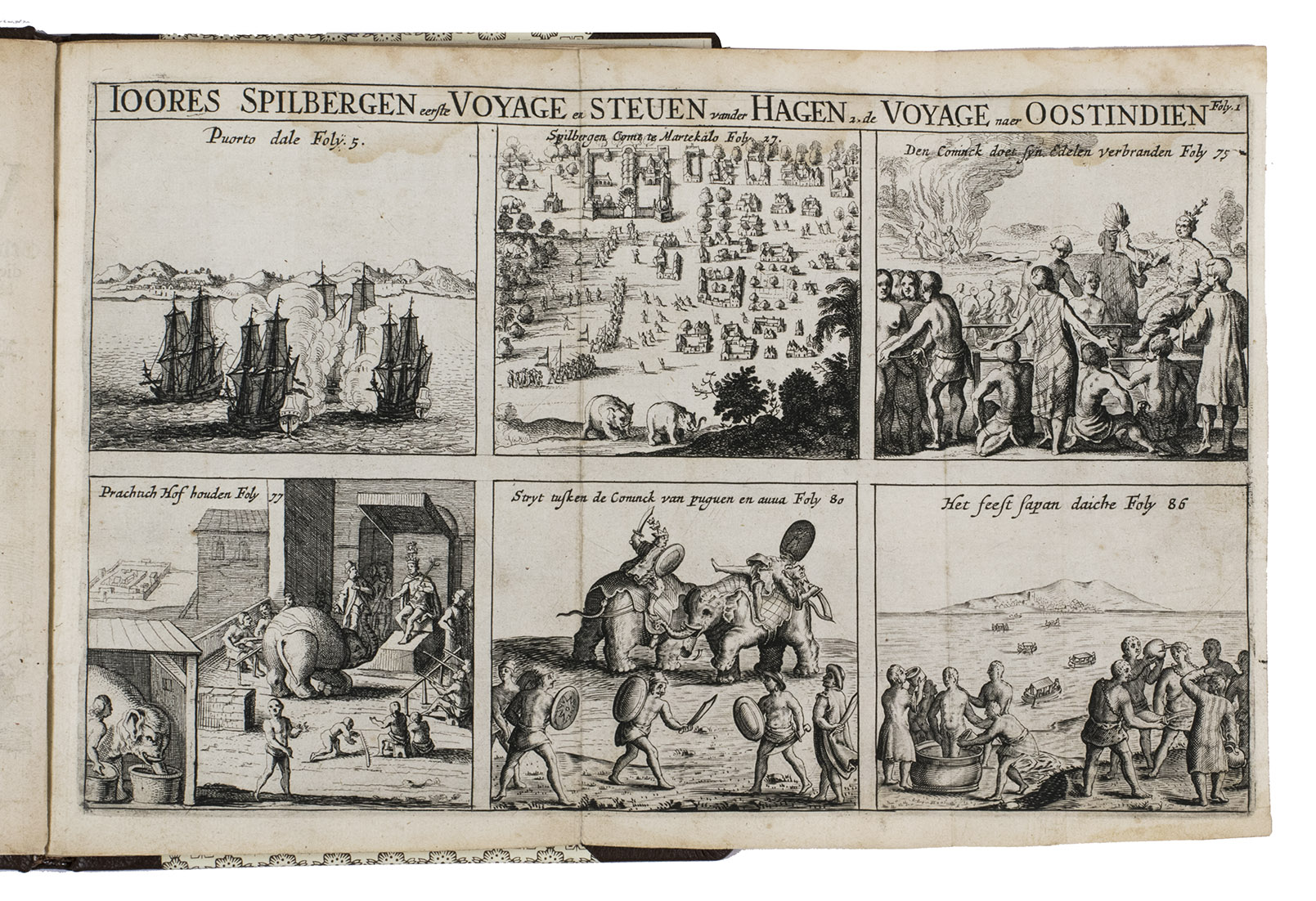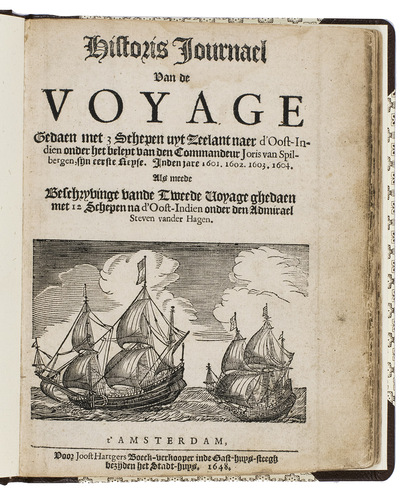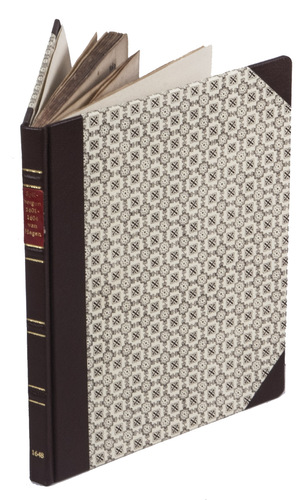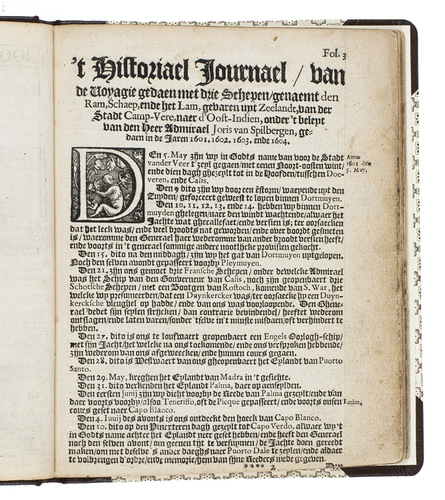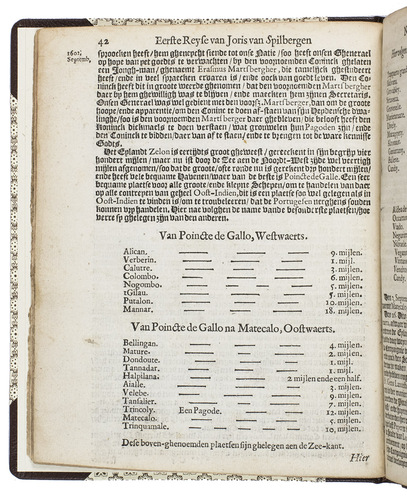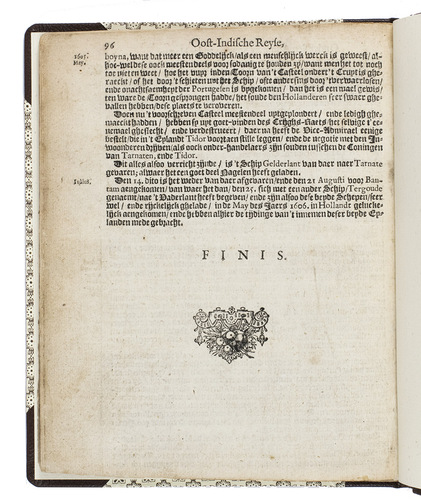SPILBERGEN, Joris van and Steven van der HAGEN.
Historis journael van de voyages gedaen met 3 schepen uyt Zeelant naer d'Oost-Indien onder het beleyt van den Commandeur Joris van Spilbergen, sijn eerste reyse. Inden jare 1601, 1602, 1603, 1604, als meede beschryvinge vande tweede voyage ghedaen met 12 schepen na d'oost-Indien onder den Admirael Steven vander Hagen.
Amsterdam, Joost Hartgers, 1648. 4to. With a relatively large woodcut illustration of two ships on the title-page, a folding engraved plate showing six scenes of Spilbergen's journey and experiences in the East, a woodcut tail-piece, and 2 woodcut decorated initials. Set in textura types with incidental roman and italic. Modern brown calf. 96 pp.
€ 6,500
Account of the famous first voyage to the East Indies by the German naval officer in Dutch service, Joris van Spi(e)lbergen (1558-1620), first published in 1605. Appended are Potanus's description of Java (pp. 57-61) and, with its own drop-title, an account of Steven vander Hagen's second voyage to the East Indies (pp. 62-96), first published in 1606. The whole, also issued in Joost Hartgers collection Oost-Indische voyagien (1648), is based on the editions of Spilbergen (including Potanus's description) and Van der Hagen published in the 10th and 12th parts of Commelin's collection Begin ende voortgangh ... (1645).
Funded by the entrepreneur Balthasar de Moucheron, Spilbergen left for the East Indies with three ships: Het Lam (the lamb), De Ram (the ram) and Het Schaap (the sheep). He sailed from Veere in Zeeland on 5 May 1601. In November he rounded the Cape of Good Hope to reach Ceylon (Sri Lanka) in May 1602. Until September the fleet was anchored at Batticaloa on Ceylon's east coast where Spilbergen negotiated with the king of Kandi, promising him military assistance against the Portuguese. Between September 1602 and March 1603 he was at Banda Atjeh, in Sumatra, negotiating with the sultan and hunting for Portuguese ships. In February 1603 ships of the newly founded Dutch East India Company (VOC) arrived at Atjeh and were joined by Spilbergen's fleet. After spending the summer of 1603 at Bantam in Java, Spilbergen returned to Holland with his two remaining ships, arriving at Vlissingen on 24 March 1604.
In 1603 the VOC appointed Steven vander Hagen to lead a voyage to the East Indies, which sailed in December 1603 with twelve heavily armed vessels taking about 1200 men. His instructions were to attack the Portuguese trading ports in India, take Malacca, and expel the Spanish from the Moluccas. Also with Vander Hagen's fleet was the yacht Duyfken under command of Willem Jansz., who was to discover Australia in 1606. In September 1605 Vander Hagen sailed for Holland leaving the Duyfken and another vessel in the Indies for further exploration, and leaving three manned forts in the Spice Islands.
The present 1648 edition appears to be the third separately published edition (after 1605 and 1617). No other separate editions are recorded so early in STCN, Picarta and WorldCat. The text was also published, however, as part of De Bry's Orientalischen Indien (1605/06) and Commelin's Begin ende voortgangh ... (1646), which may account for other editions noted in the literature.
With a bookbinder's gold-lettered black leather label on the back paste-down (BoekbinderBruns.nl). Slightly water stained in the head margin, slightly browned throughout and cut somewhat short in the foot margin, not affecting the text. Otherwise in good condition. Alden & Landis 648/181 (5 copies); Howgego, to 1800, S158; Sabin 89448; STCN (5 copies); Tiele, Bibl. 1022 & 446 note; Tiele, Mém. 143 (for V.d. Hagen see also pp. 170-171); Landwehr & V.d. Krogt, VOC 198.
Related Subjects:
